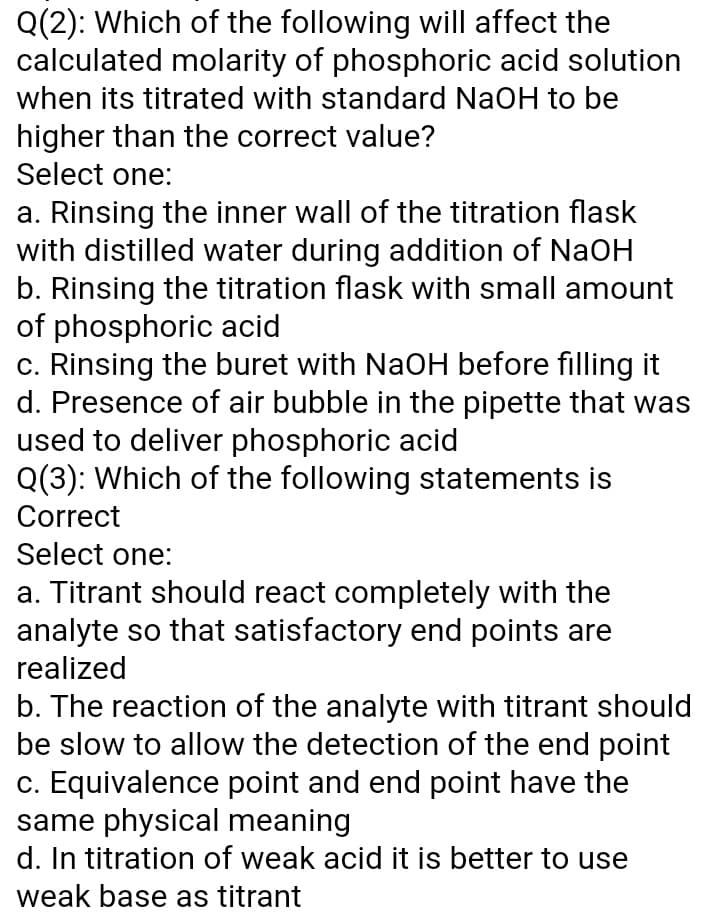Q(2): Which of the following will affect the calculated molarity of phosphoric acid solution when its titrated with standard NaOH to be higher than the correct value? Select one: a. Rinsing the inner wall of the titration flask with distilled water during addition of NaOH b. Rinsing the titration flask with small amount of phosphoric acid c. Rinsing the buret with NaOH before filling it d. Presence of air bubble in the pipette that was used to deliver phosphoric acid Q(3): Which of the following statements is Correct Select one: a. Titrant should react completely with the analyte so that satisfactory end points are realized b. The reaction of the analyte with titrant should be slow to allow the detection of the end point c. Equivalence point and end point have the same physical meaning d. In titration of weak acid it is better to use weak base as titrant
Q(2): Which of the following will affect the calculated molarity of phosphoric acid solution when its titrated with standard NaOH to be higher than the correct value? Select one: a. Rinsing the inner wall of the titration flask with distilled water during addition of NaOH b. Rinsing the titration flask with small amount of phosphoric acid c. Rinsing the buret with NaOH before filling it d. Presence of air bubble in the pipette that was used to deliver phosphoric acid Q(3): Which of the following statements is Correct Select one: a. Titrant should react completely with the analyte so that satisfactory end points are realized b. The reaction of the analyte with titrant should be slow to allow the detection of the end point c. Equivalence point and end point have the same physical meaning d. In titration of weak acid it is better to use weak base as titrant
Principles of Modern Chemistry
8th Edition
ISBN:9781305079113
Author:David W. Oxtoby, H. Pat Gillis, Laurie J. Butler
Publisher:David W. Oxtoby, H. Pat Gillis, Laurie J. Butler
Chapter15: Acid–base Equilibria
Section: Chapter Questions
Problem 57P
Related questions
Question
two questions in the analytical chemistry subject, I hope the answer is with the correct answer code

Transcribed Image Text:Q(2): Which of the following will affect the
calculated molarity of phosphoric acid solution
when its titrated with standard NaOH to be
higher than the correct value?
Select one:
a. Rinsing the inner wall of the titration flask
with distilled water during addition of NaOH
b. Rinsing the titration flask with small amount
of phosphoric acid
c. Rinsing the buret with NaOH before filling it
d. Presence of air bubble in the pipette that was
used to deliver phosphoric acid
Q(3): Which of the following statements is
Correct
Select one:
a. Titrant should react completely with the
analyte so that satisfactory end points are
realized
b. The reaction of the analyte with titrant should
be slow to allow the detection of the end point
c. Equivalence point and end point have the
same physical meaning
d. In titration of weak acid it is better to use
weak base as titrant
Expert Solution
This question has been solved!
Explore an expertly crafted, step-by-step solution for a thorough understanding of key concepts.
This is a popular solution!
Trending now
This is a popular solution!
Step by step
Solved in 2 steps

Recommended textbooks for you

Principles of Modern Chemistry
Chemistry
ISBN:
9781305079113
Author:
David W. Oxtoby, H. Pat Gillis, Laurie J. Butler
Publisher:
Cengage Learning


Chemistry: An Atoms First Approach
Chemistry
ISBN:
9781305079243
Author:
Steven S. Zumdahl, Susan A. Zumdahl
Publisher:
Cengage Learning

Principles of Modern Chemistry
Chemistry
ISBN:
9781305079113
Author:
David W. Oxtoby, H. Pat Gillis, Laurie J. Butler
Publisher:
Cengage Learning


Chemistry: An Atoms First Approach
Chemistry
ISBN:
9781305079243
Author:
Steven S. Zumdahl, Susan A. Zumdahl
Publisher:
Cengage Learning

Chemistry
Chemistry
ISBN:
9781305957404
Author:
Steven S. Zumdahl, Susan A. Zumdahl, Donald J. DeCoste
Publisher:
Cengage Learning

General Chemistry - Standalone book (MindTap Cour…
Chemistry
ISBN:
9781305580343
Author:
Steven D. Gammon, Ebbing, Darrell Ebbing, Steven D., Darrell; Gammon, Darrell Ebbing; Steven D. Gammon, Darrell D.; Gammon, Ebbing; Steven D. Gammon; Darrell
Publisher:
Cengage Learning

Chemistry: Principles and Reactions
Chemistry
ISBN:
9781305079373
Author:
William L. Masterton, Cecile N. Hurley
Publisher:
Cengage Learning